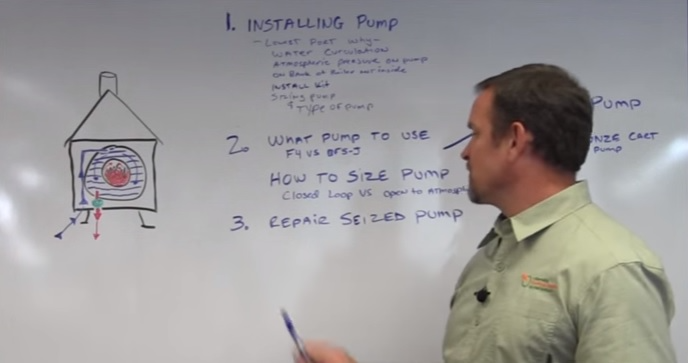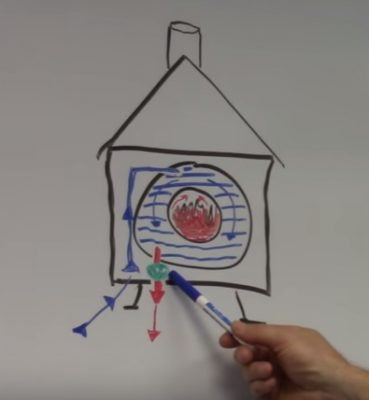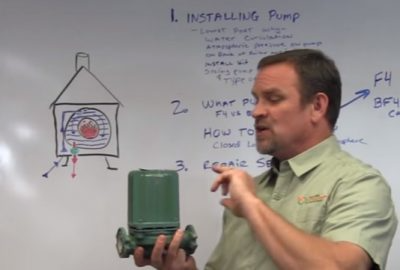How To Install Pumps on a Wood Boiler and How to Fix Broken Ones
Posted by SEBASTIAN ZOTA
This is another Alternative Heating & Supplies episode and in this blog post we are going to talk about what pumps to use for your wood boiler, how to install them, and how to fix them if anything is going wrong.
So I'm gonna break this subject down into three chapters. The first chapter is gonna be about installing the pump, all the things you need to consider when installing a pump. Chapter 2 is gonna be what pump to use, and how to size your pump for your application. And Chapter 3 is gonna be repairing a seized pump.

How to Install the Wood Boiler Pumps
Installing a Water Circulation Pump on the Back of a Wood Boiler
Things to Consider When Installing a Boiler Pump
When installing the port, you wanna install a pump, which is identified here in this green circle at the lowest port.

Installing the Pump
How do Boiler Pumps work?
And the reason why you wanna install it at the lowest port, these pumps were designed to have an equal pressure on the backside of the pump as well as the front side of the pump. Since these boilers are mainly open to the atmosphere, that means there's no pressure on the backside. We can't pressurize a unit or pressurize a loop.
So what we're gonna do is we're gonna use all this water with the weight of the atmospheric pressure of that water to pressurize the back side of that boiler because the front side, the pump is generating the pressure for. So that's the reason we want this mounted on the bottom port. So we have all that water weight on that atmospheric pressure on the back side of the boiler to try to balance it out as best as we can.
How Does the Water Circulation Work in a Boiler?
The water circulation is also a very vital important part of the outdoor wood boilers. The water jacket is around the outside, around the firebox, firebox identified in here, and this is a barrel and barrel design.
What you're gonna do here is, if you're pulling off the bottom, you're gonna be returning the water at the highest port.
What that's gonna do is that's gonna get across heat exchange from the barrel to the water. So the water is flowing down and inside that chamber, the water is heating up. So you're gonna get a cross, a circulation and transfer the heat.
At the same time, if you didn't do it that way, you would have the heat of the chamber at the hottest part and the water at the hottest part, and then you'll be pulling up top where this water would be circulating very well.
It's very, very important to get a good circulation around your wood boiler, no matter what brand or the kind you have, to make sure that all the water in the jacket is at an equal temperature as close as you can get it.
To give you the BTU factor, when you need that big burst of energy and if some of the water's not up to temperature and some is, it's not gonna do you much go when you really need it when it's cold.
Where Can you Install the Pump of a Wood Boiler?
On the back of the boiler is where you want to install the pump.
A lot of people ask, "Well, can I put it inside?" Sure, you can. But when you usually mount a pump to a wall that is mounted in your house or to a ceiling or something, it's usually mounted to the framing of the house, and the pump vibrates and makes a disturbing noise.And that's what I hear a lot of complaints about that and that's one of the reasons I don’t recommend to install it inside the house.
The other reason is that these pumps are all air-cooled, so it's better to keep the pump cool which is outside by the boiler, for efficiency reasons as well.

The Pump of a Wood Boiler
Boiler Pump Installation Kit
Now, I carry an install kit that mounts at the back of the boiler. And the reason I like the install kit, and things that you can take any consideration, and you don't have to buy my install kit, but if you like to, you can.
But the reason for the install kit is that on the supply side, which is the hot water going to the house, I mount the pump. And then on the return side, I mount a ball valve with a boiler drain so I can actually bleed the loop of any air that's in it, because what you're gonna have here is you're trying to have this pump pushing back into the water jacket where there's water, and the air can't push through the water as the pumps aren't strong enough because air compresses and the pump will compress.
So in this case, you're able to open ball valve, open the boiler drain, bleed the air out, and you now primed your loop. And that's the reason you should do that. Take that into consideration, too.
Boiler Pumps FAQs and How to Test If Your Pump is Working Properly?
Also, a lot of people will me and say, "Hey, I'm not getting any heat to the house." Well, I asked him, "Is there pump working?" And the pump will be vibrating and moving. It doesn't mean the cartridge inside is spinning or circulating the water, but again, with that boiler drain in that ball valve, you were able to close that ball valve, open the boiler drain and the water are coming out rapid, fast, and powerful, you know the pump's working. If it's not, it's trickling out like a slow leak, you know the pump's not working. Another way to test the pump, that's why these kits that I make are designed for many different facets to help you figure out and troubleshoot any problems you might have.
Check-out our next video on how to choose the proper type and size of the pump.
Until then, check out our yearly maintenance kits and do it yourself kits, and if you need assistance or you have questions that we did not cover here, give us a call!
